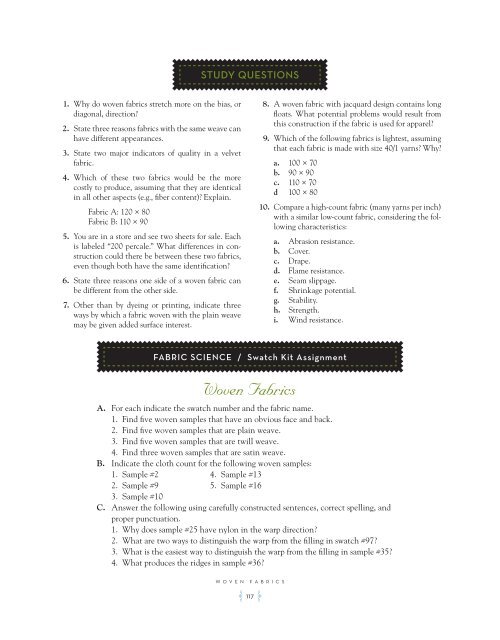Create successful ePaper yourself
Turn your PDF publications into a flip-book with our unique Google optimized e-Paper software.
1. Why do woven fabrics stretch more on the bias, or<br />
diagonal, direction?<br />
2. State three reasons fabrics with the same weave can<br />
have different appearances.<br />
3. State two major indicators of quality in a velvet<br />
fabric.<br />
4. Which of these two fabrics would be the more<br />
costly to produce, assuming that they are identical<br />
in all other aspects (e.g., fiber content)? Explain.<br />
Fabric A: 120 × 80<br />
Fabric B: 110 × 90<br />
5. You are in a store and see two sheets for sale. Each<br />
is labeled “200 percale.” What differences in construction<br />
could there be between these two fabrics,<br />
even though both have the same identification?<br />
6. State three reasons one side of a woven fabric can<br />
be different from the other side.<br />
7. Other than by dyeing or printing, indicate three<br />
ways by which a fabric woven with the plain weave<br />
may be given added surface interest.<br />
STUDY QUESTIONS<br />
WOVEN FABRICS<br />
A 117 F<br />
8. Awoven fabric with jacquard design contains long<br />
floats. What potential problems would result from<br />
this construction if the fabric is used for apparel?<br />
9. Which of the following fabrics is lightest, assuming<br />
that each fabric is made with size 40/1 yarns? Why?<br />
a. 100 × 70<br />
b. 90 × 90<br />
c. 110 × 70<br />
d 100 × 80<br />
10. Compare a high-count fabric (many yarns per inch)<br />
with a similar low-count fabric, considering the following<br />
characteristics:<br />
a. Abrasion resistance.<br />
b. Cover.<br />
c. Drape.<br />
d. Flame resistance.<br />
e. Seam slippage.<br />
f. Shrinkage potential.<br />
g. Stability.<br />
h. Strength.<br />
i. Wind resistance.<br />
FABRIC SCIENCE / Swatch Kit Assignment<br />
<strong>Woven</strong> <strong>Fabrics</strong><br />
A. For each indicate the swatch number and the fabric name.<br />
1. Find five woven samples that have an obvious face and back.<br />
2. Find five woven samples that are plain weave.<br />
3. Find five woven samples that are twill weave.<br />
4. Find three woven samples that are satin weave.<br />
B. Indicate the cloth count for the following woven samples:<br />
1. Sample #2 4. Sample #13<br />
2. Sample #9 5. Sample #16<br />
3. Sample #10<br />
C. Answer the following using carefully constructed sentences, correct spelling, and<br />
proper punctuation.<br />
1. Why does sample #25 have nylon in the warp direction?<br />
2. What are two ways to distinguish the warp from the filling in swatch #97?<br />
3. What is the easiest way to distinguish the warp from the filling in sample #35?<br />
4. What produces the ridges in sample #36?













